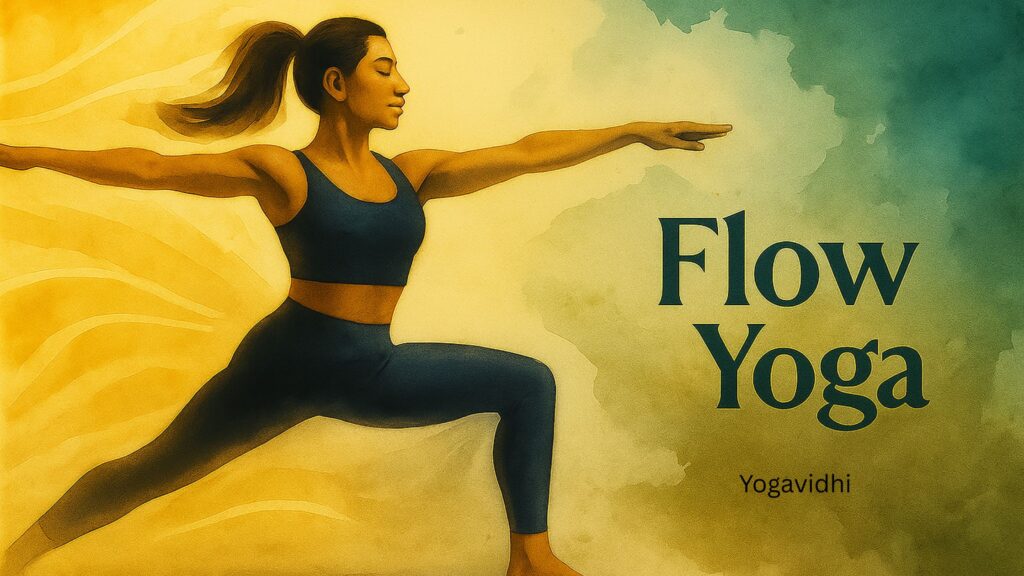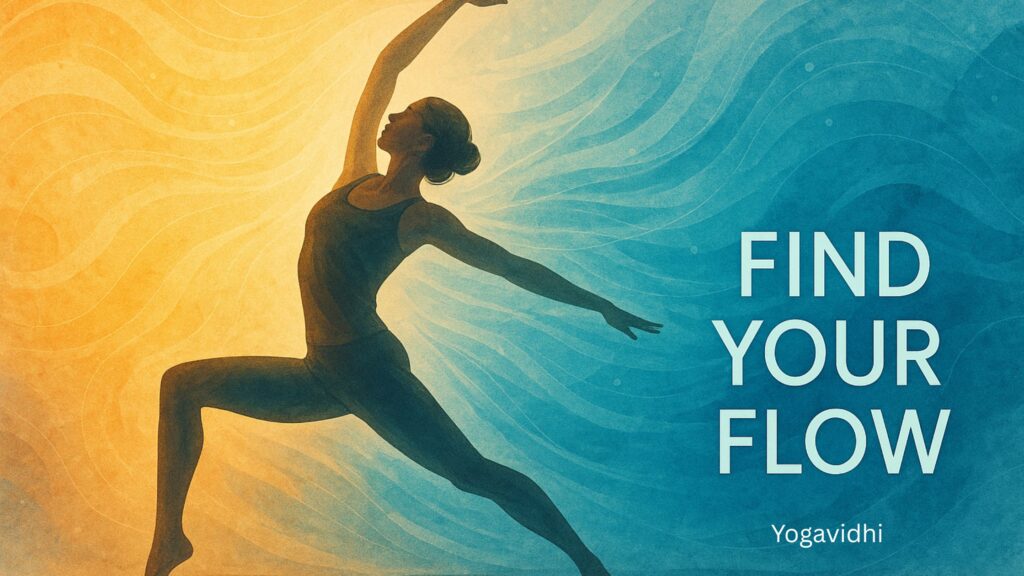In today’s fast-paced world, we crave practices that ground us, energize us, and help us reconnect with ourselves. One such transformative practice is Flow Yoga — a dynamic, breath-synchronized style of yoga that offers both physical vitality and inner peace. Whether you’re new to yoga or looking to deepen your practice, Flow Yoga can be the gateway to a healthier, more balanced life.
Flow yoga, often referred to as Vinyasa yoga, is a dynamic and fluid practice where each movement is connected to the breath, forming a seamless sequence of poses. This style is marked by smooth transitions between postures, guided by inhalation and exhalation, resulting in a mindful and invigorating experience.
Table of Contents
What is Flow Yoga?
Flow Yoga, also known as Vinyasa Flow, is a style of yoga where poses are linked together in a smooth, flowing sequence. Unlike more static forms like Hatha Yoga, Flow Yoga emphasizes continuous movement, with each posture transitioning seamlessly to the next — all coordinated with mindful breathing.
The word “vinyasa” in Sanskrit translates to “placing in a special way,” referring to the intentional sequencing of poses. This moving meditation connects breath and movement, creating a dance-like rhythm that strengthens the body and calms the mind.
Why Flow Yoga is So Popular
Search trends reveal a growing interest in dynamic yoga styles that improve fitness while offering mental clarity. Flow Yoga ranks high among the most searched yoga practices, and for good reason:
- It’s accessible to all levels
- It’s a full-body workout
- It reduces stress and promotes mindfulness
- It’s creative and never boring
People are drawn to Flow Yoga for its energizing and meditative qualities. It’s not just exercise it’s a moving spiritual practice that meets you where you are.
The Philosophy Behind Flow Yoga
At the heart of Flow Yoga is breath awareness. Each movement is guided by an inhale or exhale, anchoring your mind in the present moment. This continuous flow mirrors the natural cycles of life: movement and stillness, effort and ease.
Flow Yoga encourages practitioners to:
- Be present in every transition
- Honor their body with modifications
- Flow with intention, not perfection
Unlike rigid yoga styles, Flow Yoga offers fluidity and creativity, making each practice uniquely yours.
Top Benefits of Flow Yoga
Physical Benefits
- Improved Flexibility & Mobility – Flowing through a wide range of poses gently stretches muscles and increases joint range.
- Builds Strength – Holding postures like Plank, Chaturanga, and Warrior poses activates and tones muscles.
- Enhances Balance – Regular flow sequences improve body awareness and core stability.
- Boosts Cardiovascular Health – The dynamic nature of Flow Yoga elevates heart rate and supports circulation.
Mental & Emotional Benefits
- Reduces Stress & Anxiety – Focusing on breath and movement calms the nervous system.
- Increases Mindfulness – Flow Yoga becomes a moving meditation, promoting awareness and presence.
- Improves Mood – The combination of movement and breath boosts endorphins and emotional well-being.
Energetic & Spiritual Benefits
- Aligns Chakras – Flow Yoga harmonizes prana (life force) and clears energy blockages.
- Promotes Inner Connection – The mindful flow fosters self-inquiry and inner peace.
Essential Flow Yoga Poses for All Levels
Whether you’re practicing Flow Yoga at home or in a studio, you’ll encounter foundational poses that form the core of most sequences:
- Mountain Pose (Tadasana) – The starting point for grounding.
- Downward-Facing Dog (Adho Mukha Svanasana) – A staple for strength and stretch.
- Sun Salutations (Surya Namaskar A & B) – A flowing warm-up that integrates breath and movement.
- Warrior I, II, III (Virabhadrasana Series) – Builds strength, stability, and focus.
- Chaturanga Dandasana (Low Plank) – Strengthens arms, shoulders, and core.
- Upward-Facing Dog / Cobra – Opens the chest and spine.
- Seated Forward Fold (Paschimottanasana) – Calms the mind and lengthens the back.
- Bridge Pose (Setu Bandhasana) – Builds core and back strength.
- Savasana (Corpse Pose) – Essential for integration and deep rest.
What to Expect in a Flow Yoga Class
A typical Flow Yoga class lasts 45–75 minutes and may include:
1. Centering & Breathwork (Pranayama)
You begin by tuning in—connecting to breath and setting an intention.
2. Warm-Up
Gentle stretches prepare the body for dynamic movement.
3. Flow Sequence
This is the heart of the practice—a creative sequence of standing, balancing, and floor poses synchronized with breath.
4. Cool Down
Stretches and longer holds help the body relax.
5. Final Relaxation (Savasana)
You rest in stillness to absorb the practice.
| Category | Details |
| Definition | A dynamic style of yoga where poses are linked in a continuous, flowing sequence with the breath. |
| Core Principle | Breath-synchronized movement (vinyasa) |
| Origin | Rooted in Ashtanga Yoga; evolved as a more fluid and creative variation |
| Ideal For | Beginners, intermediates, and advanced practitioners |
| Popular Flow Poses | Sun Salutations, Downward Dog, Warrior Series, Chaturanga, Upward Dog |
| Physical Benefits | Builds strength, enhances flexibility, boosts cardio fitness, improves balance |
| Mental Benefits | Reduces stress, promotes mindfulness, enhances focus |
| Spiritual/Energetic Benefits | Aligns chakras, fosters inner awareness, balances prana (life force) |
| Class Structure | Centering, Warm-Up, Flow Sequence, Cool Down, Final Relaxation (Savasana) |
| Suitable for Beginners | Yes – with modified poses and slower-paced flows |
| Flow Yoga vs Vinyasa | Flow Yoga is a form of Vinyasa, often more creative and intuitive in transitions |
| Practice Frequency | 3–5 times per week recommended for best results |
| At-Home Practice Tips | Use online classes, build sequences from Sun Salutations, stay consistent |
| Common Myths | “Too fast,” “Only for flexible people,” “Not spiritual enough” |
| Weight Loss Benefits | Supports fat burn, increases metabolism, builds lean muscle |
Flow Yoga for Every Level
One of the beauties of Flow Yoga is its adaptability. Here’s how it suits different experience levels:
Beginners
- Learn foundational poses
- Slow-paced flows
- Emphasis on alignment and breath
Intermediate
- Introduces longer sequences and transitions
- Builds strength and endurance
- Adds balancing and twisting poses
Advanced
- Incorporates arm balances and inversions
- Deep backbends and creative transitions
- Breath control and energetic awareness
Flow Yoga vs. Vinyasa Yoga: What’s the Difference?
Many people wonder: Is Flow Yoga the same as Vinyasa Yoga? The answer is: Yes, with subtle distinctions.
- Vinyasa Yoga is the broader category referring to movement synchronized with breath.
- Flow Yoga is often used interchangeably but can imply a more creative, less rigid structure.
In essence, all Flow Yoga is Vinyasa, but not all Vinyasa classes emphasize the same fluidity and variation that Flow Yoga promotes.
Tips for a Successful Flow Yoga Practice
If you’re ready to begin or deepen your Flow Yoga journey, keep these tips in mind:
Breathe First – Your breath is your guide. Let it lead your movement.
Start Slow – Master the basics before progressing to complex flows.
Be Consistent – A regular practice brings long-term transformation.
Honor Your Body – Modify when needed. Flow Yoga is about your journey.
Let Go of Perfection – Focus on presence, not performance.
Practicing Flow Yoga at Home
You don’t always need a studio to enjoy Flow Yoga. With a yoga mat, some space, and the right attitude, your living room can become a sacred sanctuary.
Helpful Tips:
- Use online Flow Yoga classes or YouTube videos.
- Start with Sun Salutations and add on.
- Keep sessions short and consistent (15–30 minutes to start).
- End every session with Savasana.
Common Myths About Flow Yoga
Let’s bust some common misconceptions:
“You need to be flexible to do Flow Yoga.”
Flexibility comes with practice—not a prerequisite.
“Flow Yoga is too fast for beginners.”
Classes range from gentle to power flow. Choose what suits you.
“It’s not spiritual like traditional yoga.”
Flow Yoga integrates breath, intention, and mindfulness—making it deeply meditative.
Flow Yoga for Weight Loss & Energy Boost
Because Flow Yoga is continuous and often brisk, it can burn calories and elevate metabolism. Coupled with strength-building poses and conscious breathing, it becomes a powerful tool for:
- Weight management
- Detoxification through sweat
- Boosting energy levels naturally
Make it part of your morning routine, and you’ll feel the difference all day.
Read More: Yoga for Beginners: Your Ultimate Guide to Start a Life-Changing Journey
Read More: Kriya Yoga: Unlocking Inner Power Through Ancient Yogic Science

Conclusion: Embrace the Flow
Flow Yoga is more than a workout—it’s a lifestyle. It teaches you to move with intention, breathe through life’s challenges, and find grace in motion. Whether you’re stepping on the mat to build strength, relieve stress, or connect with your spirit, Flow Yoga meets you with open arms.
Ready to begin?
Let your breath lead the way—and just flow.
Frequently Asked Questions (FAQs)
Q. Is Flow Yoga good for beginners?
Ans: Yes! Many Flow Yoga classes are beginner-friendly and focus on foundational poses and breathing.
Q. How often should I practice Flow Yoga?
Ans: 3–5 times a week is ideal for noticeable physical and mental benefits.
Q. Can Flow Yoga help with stress?
Ans: Absolutely. The breath-focused sequences are great for calming the nervous system.
Q. What’s the difference between Flow Yoga and Power Yoga?
Ans: Power Yoga is more intense and fitness-focused, while Flow Yoga emphasizes breath and creative transitions.
Q. Do I need props for Flow Yoga?
Ans: Optional. Blocks, straps, and bolsters can support your practice, especially as a beginner.
Q. What does flow yoga do?
Ans: This style of yoga emphasizes the harmony between breath, movement, and the mind. Rooted in the traditions of Hatha Yoga, Vinyasa Yoga, and Ashtanga Vinyasa, it is commonly known as “flow” yoga due to its seamless transition from one pose to the next in a smooth, continuous sequence.
Q. What is the difference between flow yoga and yoga?
Ans: Yoga flow classes are among the most popular contemporary styles of yoga and are widely available at most studios. These classes don’t follow a fixed sequence of poses, allowing each instructor to customize the session. Some may guide students through poses rapidly, while others may opt for a slower, more deliberate pace.
Q. How difficult is flow yoga?
Ans: Flow yoga’s continuous sequence of poses can be intense for beginners or individuals with limited mobility. Additionally, the repetitive nature of the practice may cause overuse injuries if proper alignment and modifications are not followed.
Q. Is flow yoga good for weight loss?
Ans: Hot Vinyasa yoga is a form of yoga where Vinyasa flow sequences are practiced in a heated room. The elevated temperature makes the practice more intense, as you’ll be moving through poses while working up a serious sweat. If your goal is to burn a significant number of calories, hot yoga or Bikram yoga combined with Vinyasa flow is an excellent option.
Declaration Note:
We use third-party videos and images on https://yogavidhi.com/ for educational and illustrative purposes. All rights belong to their respective owners. No copyright infringement is intended.



